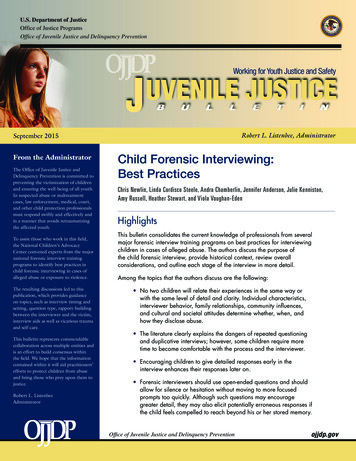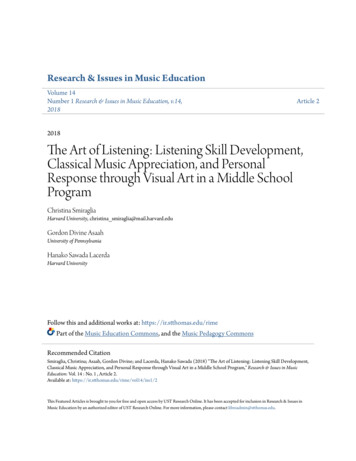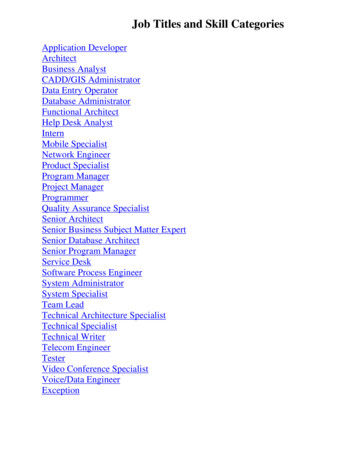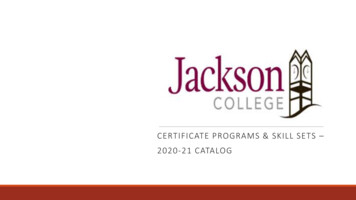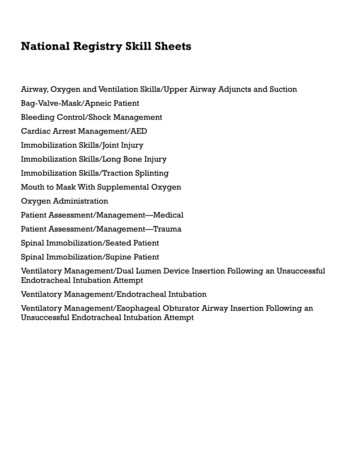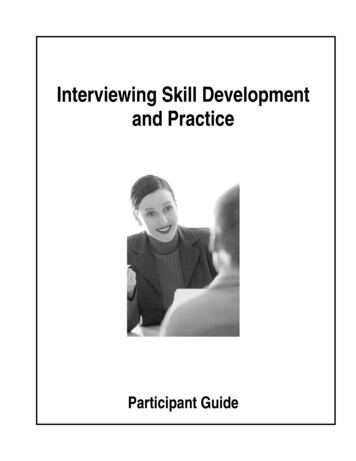
Transcription
Interviewing Skill Developmentand PracticeParticipant Guide
TABLE OF CONTENTSREFERENCES/WORKSHEETSCourse Description and Learning ObjectivesPage Number3Course Agenda4Module One - Solution Building ApproachStages of Problem Solving vs. Stages of Solution Building5Module Two - EngagementWorksheet: Video Presentation - Tim, Part 16Question Formulation: Opening the Interview and Developing Rapport7Strategies for Home Visits8Interviewing Skills Checklist9Language Techniques That Promote Solution-Focused Interviewing10Question Lead-Ins13Module Three - Investigative InterviewsCasework Practice vs. Protective Authority14Components of the Protective Authority Model15Components of the Casework Model16Worksheet: Video Presentation - Forrester Family, Part 117Dealing with Issues Related to the Case Manager’s Authority19Question Formulation: Assessment21Latino Culture - Communication Styles23Module Four – Defusing Anger/Assessment InterviewingDefusing Other People’s Anger26Examples - Miracle Question, Exception Finding Questions, and Scaling Questions33Worksheet: Video Presentation - Forrester Family, Part 240Question Formulation: Change Strategies41Question Formulation: Reassuring and Supporting42Module Five – Interviewing for Client ProgressWorksheet: Video Presentation - Tim, Part 243End of Session Feedback for Tim44Interviewing Skills Strengths and NeedsInterviewing Skill Development & Practice472March 2007
INTERVIEWING SKILL DEVELOPMENT AND PRACTICEThis course is designed to provide you with an opportunity for interviewing skilldevelopment and practice through the use of structured role-plays and feedbacksessions. The course builds upon the content delivered in the Keys to Child WelfarePractice new worker curriculum and also provides instruction on additionalinterviewing techniques and the application of these techniques to caseworkpractice. Also, this course is designed to help you develop confidence in conductinginterviews and to expose you to the importance of reflective self-assessment.Course Goals:Upon completion of this course, you should be able to: Choose specific interviewing techniques to apply in various caseworksituationsEffectively interview parents and/or collateral contacts in order to gatherinformation, motivate parents toward change, and promote safety andpermanency for childrenEngage in reflective self-assessment of your practiceLearning Objectives: Identify individual strengths and needs regarding interviewing skillsRecognize how basic interviewing skills can be used as solution buildinginterviewing techniquesGiven a specific case scenario, plan a purposeful casework interviewGiven a specific case scenario, identify interviewing strategies for conductinga casework interviewGiven a specific case scenario, use specific interviewing techniques, includingsolution building techniques, to complete a parent or collateral contactinterviewApply DFCS social services policy and practice in interviewing situationsCritically assess interviews conducted by peers and self and providemeaningful feedbackInterviewing Skill Development & Practice3March 2007
COURSE AGENDAOPENING ACTIVITIESMODULE 1 – SOLUTION BUILDING APPROACHSection A: The Foundation - Casework InterviewingSection B: Solution Building Approach to Casework InterviewingSolution Building Interviewing ToolsMODULE 2 – SKILL DEVELOPMENT AND PRACTICE - ENGAGEMENTSection A: Engagement PresentationSection B: Abernathy Family case scenario - videotaped interviewsSection C: Video Review and FeedbackSection D: Solution Building Interviewing ToolsMODULE 3 – SKILL DEVELOPMENT AND PRACTICE – INVESTIGATIVE INTERVIEWSSection A: Investigative Interviewing PresentationSection B: Cedeno Family case scenario - videotaped interviewsSection C: Video Review and FeedbackMODULE 4 - SKILL DEVELOPMENT AND PRACTICE – DEFUSING ANGER ANDASSESSMENT INTERVIEWINGSection A: Defusing Anger PresentationSection B: Assessment Interviewing Presentation/Solution Building Interviewing ToolsSection C: Jones Family case scenario - videotaped interviewsSection D: Video Review and FeedbackMODULE 5 - SKILL DEVELOPMENT AND PRACTICE – INTERVIEWING FOR CLIENTPROGRESSSection A: Interviewing for Client Progress PresentationSection B: Kimball Family case scenario – videotaped interviewsSection C: Video Review and FeedbackCLOSING ACTIVITIESInterviewing Skill Development & Practice4March 2007
STAGES OF PROBLEM SOLVING VS. STAGES OF SOLUTION BUILDINGSTAGES OF PROBLEM SOLVINGSTAGES OF SOLUTION BUILDINGDescription of problem(s) and datacollection. The client describes his concerns.The practitioner asks follow-up questions toobtain a more detailed understanding of theclient’s problem so that a professionalassessment can be made.Describing the problem. Clients are given anopportunity to describe their problems.However, much less time and effort is spenthere in solution building. Fewer details aregathered about the nature and severity ofproblems and the possible causes of theproblems are not explored.Problem assessment. The practitionermakes a determination of the nature of theclient’s problem and its seriousness. Thepractitioner draws from his profession’sknowledge base to make the assessment.Developing well-formed goals. Practitionerswork with clients to elicit descriptions of whatwill be different in their lives when theirproblems are solved. This is done at the pointwhere an assessment would be conducted iffollowing the problem solving approach.Intervention planning. Together with theclient, the practitioner develops a list of goalsand designs a set of interventions intended tosolve or reduce the negative consequences ofthe client’s problem (s). The practitioner relieson his profession’s knowledge base indeveloping the plan.Exploring for exceptions. Practitioners askabout those times in clients’ lives when theirproblems are not happening or are lesssevere. Practitioners also ask about who didwhat to make the exceptions happen. Thisstep substitutes for intervention planning in theproblem solving approach.Intervention. The problem-solving actions(i.e. interventions) intended to alleviate theproblem are carried out.End of session feedback. Messages given toclients at the end of each solution-buildingconversation. The feedback is based oninformation the client has revealed and alwaysfocuses on what the client needs to do more ofand/or do differently in order to meet theirgoals. Feedback is given at the point whereproblem-solving practitioners would be carryingout their interventions.Evaluation and follow up. As theinterventions are implemented, the client andprofessional monitor the results. Theinformation from the monitoring is used todecide if the actions taken have beensuccessful. If not, adjustments are made ornew actions taken. Once the problem isdeemed solved by the client and practitioner,the client stops services.Evaluating client progress. Regularevaluation of how clients are doing in reachingsolutions. Includes working with clients toexamine what still needs to be done beforethey feel their problems have been adequatelysolved and they are ready to stop services.ndAdapted from “Interviewing for Solutions,” 2 Ed., Peter DeJong & Insoo Kim BergInterviewing Skill Development & Practice5March 2007
VIDEO PRESENTATION: TIM, PART 1Topic: Initial client engagement using a solution building approach.Directions: Use this worksheet to jot down your observations about this interview.After the video, we will discuss your observations.What did you observe that the interviewer did that was useful?What else could the interviewer have done to be even more useful?My reaction to this type of approach with clients.Interviewing Skill Development & Practice6March 2007
QUESTION FORMULATION:OPENING THE INTERVIEW AND DEVELOPING RAPPORTThe following are sample question formulations and responses that can be used foropening the interview and developing rapport. These can serve as a model forformulating your own questions and responses to meet the unique situation in eachcase."May I talk with you for a few minutes?" (Note the use of "with" rather than "to”)"Where would you be most comfortable meeting with me?""I want to understand this from your point of view.”"Maybe you'd like to ask me some questions before I ask you mine?""Do you have any concerns about our agency? Or about me? I'd be glad to answerthem”"I'd like us to work together. You may not believe that. I understand you'll need to getto know me better before you feel confidence in me.”"I'd prefer not to do anything against your wishes. But I really would like for you towork with me; otherwise, we can't work out a solution that we can both agree on toprotect Larry.”"I know this is hard for you. I'll try to make it as comfortable as I can.”"That's what we need to discuss. Where would you like to begin?""Please let me know if I say things you don't understand, or that bother you.”"Would you be willing to hear me out before you make a decision?”Adapted from Child Welfare League of America, Field Guide to Child Welfare, Volume IIInterviewing Skill Development & Practice7March 2007
STRATEGIES FOR HOME VISITSBelow are possible strategies for home visits. You must be comfortable with the strategy touse it effectively, so personalize the strategy to fit your style. The more strategies you haveat your disposal, the more flexible and successful you will be with your clients.Door-to-door salesperson(good for first contacts) Power of silenceA smile on your face.Identify yourself while extending yourbusiness card.Ask to enter the home pleasantly: "May Icome in?"Do not discuss the nature of your visituntil entering the home. Pleasant demeanor.If you are aware of client needs, such asfood, diapers, or other concreteassistance, bring it with you.Incorporate your "free sample" intorequest to enter or to speak with client. Knock on door loudly and persistently.Use firm, no-nonsense voice.Be prepared with concrete informationabout the client's behavior: "I was hereon the fifth, the tenth, and the twelfth.There was talking and noise from theapartment, but no one answered." If client has a positive workingrelationship with another case manageror colleague, ask that person toaccompany you. Have the known,trusted party introduce and endorse you.Implied intimidation rub-off(good for strong resistance or those with lawenforcement connections)Lieutenant Colombo approach If it is not an emergency and the clientwill not allow entry, ask for a convenienttime to return.Do not discuss the nature of the referral.If there is a potential issue of domesticviolence, be open to negotiating adifferent setting for meeting.Good guy rub-offThe stick(good for clients who have avoided you) Speak very softly.Use short, simple statements andquestions.Allow the client plenty of time to answer.Be relaxed and non-accusatory.You must be comfortable with silence.NegotiationThe carrot(good for passive-resistance or to gainsubsequent contacts with family) Ask client for assistance.Express confusion and requestclarification.Be very low-key and non-threatening. If the client is on probation or parole,ask the officer to accompany you.If there is a history of law enforcementinvolvement, request an officer toaccompany you.Adapted from CalSWEC Core Curriculum, Conducting Interviews, April 2001Interviewing Skill Development & Practice8March 2007
Interviewing Skills ChecklistInterviewer’s NameDirections:For each skill, rate each interviewer using the scale below.Rating Scale 1 to 41 Didn’t demonstrate this skill, although there was an opportunity to do so.2 Demonstrated this skill, but did not seem at ease. Please keep working on it.3 Somewhat at ease with this skill and used it fairly effectively. Please do more of this in yourinterviews. The more you do it, the more comfortable you will become.4 Totally at ease with this skill and used it very effectively. Great job!N/A I didn’t think this skill was applicable to this interviewing situationSKILLSMaking introductionsExplaining roleCommunicating purpose of interviewAddressing interviewee by nameNoticing client’s communication style and adjusting accordinglyPutting client at easeDeveloping rapportExplaining confidentiality and addressing interviewee’s concernsBalancing authorityAcknowledging and responding to cultural differencesResponding to anger, hostility, “attitude”Active listeningExploring client’s key words (i.e. echoing)Summarizing at appropriate times.ParaphrasingUsing silence at appropriate timesUsing open-ended questionsUsing clarifying questionsUsing scaling questionsUsing relationship questionsUsing the Miracle Question at appropriate timesExploring for exceptions (using exception finding questions)Identifying and amplifying client strengthsAvoiding “why” questions and leading questionsMaintaining a position of not knowingFormulating next question from interviewee’s last questionGiving complimentsKeeping the interview on track or refocusing if neededGathering informationCommunicating informationMirroring appropriate nonverbal communication behaviorsDetermining if interview goals have been accomplishedSummarizing interviewReviewing agreed upon tasks/steps/goalsPraising/complimenting intervieweeInviting questions from intervieweeInterviewing Skill Development & Practice91234March 2007N/A
LANGUAGE TECHNIQUES THAT PROMOTESOLUTION- FOCUSED INTERVIEWINGSuppose, (pause) .This is a good way to help families begin to imagine an alternative future withoutimplying that their preferred future will occur. It is good practice to use pauses tohelp families make the transition to thinking about alternatives to problems.e.g. “Suppose you were able to find ways to have your children do what you tellthem to do, (pause) .what would they notice you doing differently with them.”InsteadIt is quite normal for families to not know what they want when they first meet withthe case manager. Sorting this out usually begins by talking about what they do notwant. Be prepared to help families define what they want by building on what theyfind troublesome. The word ‘instead” is very useful.e.g. “Instead of ‘screaming at the kids’, what would you do?”“When,” not ‘if”“When” encourages a future focus and creates more hope that a different way couldhappen. “If” retains the future focus, but introduces more doubt.e.g. “When you are able to talk to your kids in a normal tone of voice, what will bedifferent at your home?”“How come?”This question is less confrontational and accusatory than “why” and asks: “”Whatwere you thinking?”e.g. “How come you decided to respond to your children’s misbehavior differentlyfrom how your mother responded to you as a child?”Interviewing Skill Development & Practice10March 2007
Using silence and responding to “I don’t know”Because the questions we ask families are difficult and require thought, they oftenfall silent or say “I don’t know.” When that happens, try (first) sitting back, looking expectantly, and waiting for an answer, saying: “I am asking some tough questions” and wait some more, saying: “If you were to guess, what would you say?” using relationship questions like “What would your husband say that he seesthat tells him that you no longer have this problem?” reviewing how the agency became involved with the family; that is, looking atwho is the “real client” in this case, that is, the person who wants somethingdifferent; then proceed to relationship questions that build around the “realclient.” For example, “When Social Services got involved with your family, youtold me that you wanted to find a way to have your children behave that didn’tinvolve hitting or yelling at them. You said you wanted to raise your childrendifferently from the way your mother raised you. What do you suppose thejudge wants to see different as the result of our talking?”Difference questionsFamilies make changes when they notice something is different in their lives thedifference gives them ideas about what they do to bring on further changes.Therefore expect to use the word “different” frequently in your questions.e.g. .“What will you notice different about your children that will let you know thata miracle has happened and their problems in following your instructions aresolved?”e.g. “How will you know that is really different this time”e.g. “What difference would that make in your relationship with your children?”Tentative languageTentative language is consensus building language; it invites and allows space forthe listener to offer thoughts and ideas on a topic.e.g. “I wonder what will happen when .” “Could it be that .” “Perhaps .” “Is itpossible that .”Interviewing Skill Development & Practice11March 2007
So A very useful word to use in order to break in on families who are “non-stop, problemtalkers” who “control” the situation with such talk. Once families have some time toexpress their difficulties and reactions, use “so” (not “but”, see below) followed by aparaphrase or empathic statement and then move on to solution-focused questions.The use of “so” signals to the family that a topic change is coming and gives theinterviewer a device to redirect the conversation in a more useful direction.e.g. “So, I can see that having Social Services in your life has created lots ofproblems for your family, (pause) when things start to go better, what will bedifferent?”Words or phrases to avoid“You want to , don’t you?”Such questions reflect the worker’s or Agency’s frame of reference andminimizes the importance of what the client wants different.“Yes, but .”If you are using this phrase, it is a good indication that you are about to engagein a debate with the family. We can often influence a family’s way of thinking, butwe cannot win a debate or argument. If you find yourself saying “but ”, it’s apretty good clue that you need to do something different. Get in the habit ofcatching yourself in time and experiment with other phrases. Start by asking: “Sowhat has to be different as the result of our meeting today for you to say our timetogether was worthwhile?”ndAdapted from “Interviewing for Solutions,” 2 Ed., Peter DeJong & Insoo Kim BergInterviewing Skill Development & Practice12March 2007
QUESTION LEAD-INSSometimes the most difficult aspect of trying out a new concept is getting started.This tool lists a few of the lead-ins used in solution-focused questioning.Make use of Who, What, When, Where, and How. Avoid the word "why" because ofthe negative or hostile tone it can convey.Lead-in possibilities:How will things be different?What will you notice about. . .Perhaps . . .I am not certain, do you suppose. . .Suppose. . .It seems. . .Is it possible. . .How do you want your life to be different?What will you do instead?How did you do that?How did you figure out how to do that?What else . . .What did you notice. . .What did your colleagues, supervisors, family, boss notice. . .Tell me the reason (instead of why?)Did you notice?What would it take?What would you change?What small change would you make?So . .How will you know?When things are different. . .How would that be helpful?What tells you that you are better?What is better?Tell me about. . .How can I be helpful?What would be helpful?What have you heard?Anything else. . .How do you know?ndAdapted from “Interviewing for Solutions,” 2 Ed., Peter DeJong & Insoo Kim BergInterviewing Skill Development & Practice13March 2007
CASEWORK PRACTICE VS. PROTECTIVE AUTHORITYCASEWORK PRACTICEFocus of Intervention:PROTECTIVE AUTHORITYFocus of Intervention:The family is viewed as a unit, and is theprimary focus of involvement and services.The child and the abusing or neglectful parentare each viewed individually as the focus ofintervention.Intervention Method:Intervention Method:The family is involved in a mutual caseassessment that includes both the causal andcontributing factors to maltreatment, andinherent family strengths and resources.The agenc
interviewing techniques and the application of these techniques to casework practice. Also, this course is designed to help you develop confidence in conducting interviews and to expose you to the importance of reflective self-assessment. Course Goal
